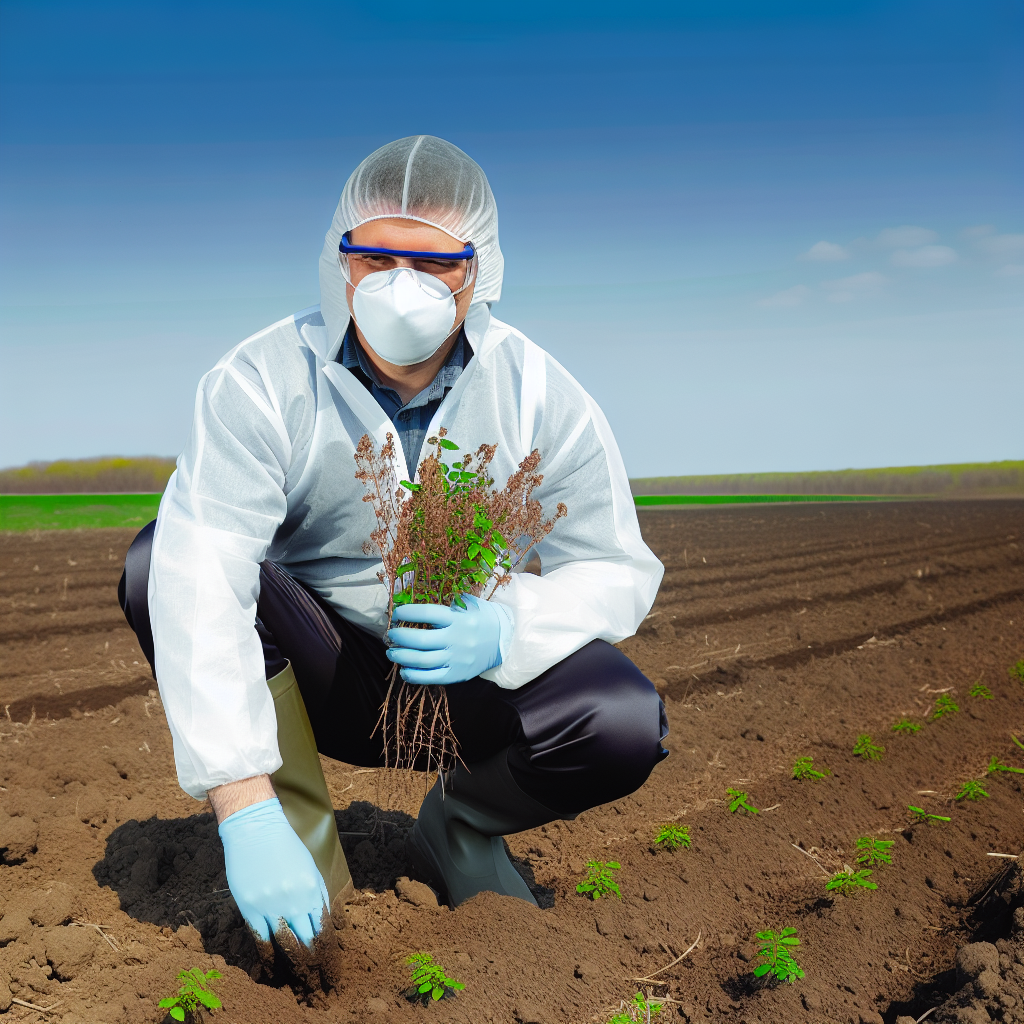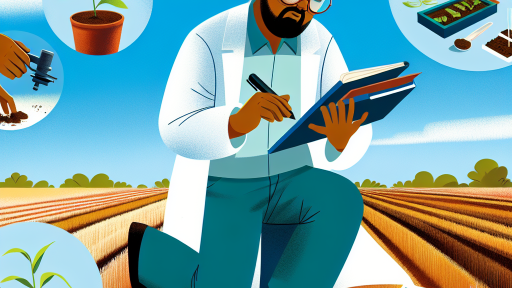Introduction to Native Plants and Their Importance in Agriculture
Defining Native Plants
Native plants are species that naturally occur in a specific region.
They have adapted to local climate conditions and soils over time.
Moreover, these plants provide essential habitats for local wildlife.
Benefits of Native Plants in Agriculture
Integrating native plants in farming systems enhances biodiversity.
This increased biodiversity promotes a balanced ecosystem.
Additionally, native plants improve soil health through deep rooting systems.
They help prevent soil erosion and maintain water quality.
Enhancing Pest Management
Native plants can attract beneficial insects and predators.
These organisms naturally control pest populations.
Consequently, farmers can reduce their reliance on chemical pesticides.
Supporting Pollinators
Many native plants offer food sources for pollinators like bees and butterflies.
This support is crucial for maintaining healthy crop yields.
Without pollinators, many fruits, nuts, and vegetables would decline.
Adapting to Climate Change
Native plants are often better suited to withstand local climate challenges.
They require less water and are more resilient to pests and diseases.
Transform Your Agribusiness
Unlock your farm's potential with expert advice tailored to your needs. Get actionable steps that drive real results.
Get StartedThis adaptability can help farmers face the impacts of climate change.
Economic Benefits
By using native plants, farmers can enhance their economic sustainability.
Native plants can reduce costs related to irrigation and fertilizers.
Furthermore, they may attract eco-conscious consumers interested in sustainable practices.
Benefits of Integrating Native Plants in Farm Systems
Enhancing Biodiversity
Native plants significantly enhance biodiversity on farms.
They provide crucial habitats for wildlife.
This conservation effort benefits pollinators and other beneficial organisms.
Additionally, diverse ecosystems tend to be more resilient against pests.
Improving Soil Health
Integrating native plants improves soil health effectively.
Their root systems help prevent soil erosion.
Moreover, native plants contribute organic matter as they decompose.
This process enhances soil structure and fertility.
Conserving Water Resources
Native plants are well adapted to local climates.
They typically require less water than non-native species.
This reduces overall irrigation needs for farms.
Water conservation becomes a valuable benefit in arid regions.
Providing Pest Management Solutions
Native plants offer natural pest management options.
Their presence attracts beneficial insects that control pests.
Additionally, this integration can reduce reliance on chemical pesticides.
Farmers can create a balanced ecosystem that naturally regulates pests.
Promoting Sustainable Practices
Integrating native plants supports sustainable agricultural practices.
They require fewer inputs such as fertilizers and pesticides.
This leads to reduced environmental impacts over time.
Furthermore, farming with native plants aligns with ecological conservation goals.
Showcase Your Farming Business
Publish your professional farming services profile on our blog for a one-time fee of $200 and reach a dedicated audience of farmers and agribusiness owners.
Publish Your ProfileIncreasing Aesthetic Value
Native plants also enhance the visual appeal of farm landscapes.
Beautiful, diverse plantings can attract visitors and enhance marketability.
This aesthetic value contributes to community engagement in agriculture.
Additionally, vibrant farms can boost local tourism opportunities.
Strategies for Selecting Appropriate Native Species for Different Agri-ecosystems
Understanding Local Ecosystems
Every agricultural system exists within a unique ecological context.
Assess local soil types, climate, and water availability.
These factors influence which native species will thrive.
Conduct soil tests to determine pH and nutrient levels.
Additionally, observe existing native vegetation in the area.
Identifying Desired Outcomes
Define the goals of integrating native species into agricultural systems.
Consider objectives such as erosion control, pest management, or pollinator support.
Different goals require different species selections.
For example, use flowering plants to attract pollinators.
On the other hand, deep-rooted species beneficially enhance soil structure.
Researching Native Species
Investigate local native plants suited to your region.
Start by consulting native plant databases or extension services.
Focus on species that display resilience and adaptability.
Regional conservation organizations can provide valuable insights.
Additionally, consider the potential for invasive species that may disrupt ecosystems.
Engaging with the Community
Collaborate with local farmers and agronomists to share knowledge.
Participate in workshops or community meetings focused on native species.
Engagement fosters a shared understanding of mutual challenges and solutions.
Furthermore, community involvement can lead to successful implementation strategies.
Evaluating Compatibility with Existing Practices
Assess how native plants will interact with current agricultural practices.
Ensure selected species fit within existing crop rotations and management techniques.
Consider potential competition between crops and native flora.
Additionally, evaluate how native species will affect farm machinery and maintenance routines.
Implementing Pilot Projects
Start small with pilot projects to evaluate the integration of native species.
Monitor plant growth and success over multiple seasons.
Collect data to understand benefits and challenges faced during implementation.
This approach reduces risks before larger-scale adoption.
Adjust strategies based on pilot project findings for better results.
Monitoring and Adjusting Strategies
Continuously monitor the success of native integration efforts.
Assess both plant health and agricultural productivity regularly.
Gather feedback from all stakeholders involved.
Use this data to adapt strategies to improve outcomes.
Flexibility enables responsive management of agricultural systems.
Gain More Insights: Soil Testing Methods For Better Farm Yields
Case Studies: Successful Implementation of Native Plants in Crop Production
Introduction to Case Studies
This section highlights successful integration of native plants in agriculture.
We explore various case studies demonstrating beneficial outcomes.
Showcase Your Farming Business
Publish your professional farming services profile on our blog for a one-time fee of $200 and reach a dedicated audience of farmers and agribusiness owners.
Publish Your ProfileCase Study 1: Enhancing Biodiversity with Prairie Grasses
A farm in Illinois utilized prairie grasses alongside corn and soybeans.
This approach attracted beneficial insects and improved pollination.
Farmers noticed increased yields and reduced pest populations.
Key Strategies
- Planting native prairie grasses in field borders.
- Creating habitat for pollinators and natural pest predators.
- Enhancing soil properties through diverse root systems.
Case Study 2: Native Wildflowers and Crop Resilience
A vineyard in California integrated native wildflowers into its landscape.
This strategy improved ecological resilience during drought conditions.
The winery reported better water retention and healthier vines.
Implementation Techniques
- Interspersing wildflowers among grapevines.
- Utilizing deeper-rooted plants to improve soil moisture.
- Creating a balanced ecosystem for pest control.
Case Study 3: Organic Farm Utilizing Native Shrubs
An organic farm in Maine adopted native shrubs for erosion control.
These shrubs reduced soil erosion while providing habitat for wildlife.
Farmers noticed less runoff and improved nutrient retention.
Benefits Observed
- Reduced soil loss during heavy rains.
- Increased soil fertility over time.
- Enhanced farm biodiversity and wildlife habitat.
Summary of Insights
These case studies illustrate that native plant integration yields positive results.
Farmers gain both ecological and economic advantages.
Adopting these practices can lead to more sustainable agricultural systems.
Discover More: Using Biochar To Enhance Soil Fertility
Role of Native Plants in Enhancing Biodiversity and Ecosystem Services
Importance of Native Plants
Native plants play a crucial role in supporting local ecosystems.
They provide essential habitats for various species.
Additionally, they contribute to soil health and stability.
Native plants enhance pollinator activities in agricultural areas.
Benefits to Biodiversity
Integrating native plants increases species diversity in landscapes.
This diversity promotes a resilient ecosystem capable of withstanding stress.
Different species can coexist, providing various ecological functions.
Moreover, these plants support food webs by attracting specific fauna.
Ecosystem Services Provided by Native Plants
Native plants improve water retention and quality in agricultural systems.
They help mitigate soil erosion through their extensive root systems.
Furthermore, they contribute to carbon sequestration efforts.
Native plants also promote nutrient cycling within ecosystems.
Influence on Pest Management
Utilizing native plants can aid in the natural control of pests.
They can attract beneficial insects that prey on harmful pests.
This creates a more balanced and healthy agricultural environment.
Support for Traditional Farming Practices
Integrating native vegetation aligns with traditional agricultural practices.
These methods often rely on biodiversity to maintain crop health.
Such integration fosters a deeper connection between cultures and nature.
Future Directions in Research and Implementation
Further research will enhance our understanding of native plants’ roles.
Practical applications and guidelines will encourage their use.
Ultimately, integrating native plants in agricultural systems is beneficial.
Discover More: Integrating Crop Diversity into Your Farming Practices

Methods for Assessing Soil Health and Sustainability with Native Plant Integration
Introduction to Soil Health Assessment
Assessing soil health involves multiple indicators.
These indicators help farmers understand soil quality.
Healthy soil is the foundation of sustainable agriculture.
Consequently, integrating native plants enhances soil health.
Key Soil Health Indicators
Soyland organic matter is a critical indicator.
Showcase Your Farming Business
Publish your professional farming services profile on our blog for a one-time fee of $200 and reach a dedicated audience of farmers and agribusiness owners.
Publish Your ProfileIt improves soil structure and fertility.
Microbial activity indicates a vibrant ecosystem.
Additionally, nutrient cycling supports plant growth.
Soil pH affects nutrient availability.
Measuring soil moisture levels indicates water retention capacity.
Benefits of Integrating Native Plants
Native plants improve biodiversity in agricultural systems.
They attract beneficial insects and pollinators.
Further, they enhance soil microbial diversity.
This integration helps improve soil structure and stability.
Moreover, native plants require less water and fertilizers.
Practical Techniques for Assessment
Farmers can conduct soil tests regularly.
These tests analyze organic matter and nutrient levels.
Field observations provide immediate insights into soil conditions.
Visual assessments identify erosion signs and compaction issues.
Integrating Native Plants in Agricultural Practices
Farmers can incorporate native plants into crop rotations.
Cover cropping with native species enhances soil health.
Buffer strips with native vegetation protect water bodies.
These practices improve water infiltration and reduce runoff.
Community and Research Collaboration
Farmers should collaborate with local universities.
Research institutions offer valuable resources and expertise.
Sharing knowledge fosters innovative practices.
Community workshops can educate on native plant benefits.
Find Out More: Sustainable Farm Pathways And Access Planning Essentials
Challenges and Mitigation Strategies in Integrating Native Plants into Traditional Farming
Identifying Key Challenges
Integrating native plants into agricultural systems presents several challenges.
Farmers often face a lack of knowledge about suitable native species.
Additionally, farmers may resist change from established farming practices.
Another issue is the potential competition between native plants and crops.
Moreover, regulatory hurdles often impede integration efforts.
Developing Education and Resources
Providing education is crucial for overcoming resistance to native plants.
Workshops and training sessions can enhance farmer knowledge.
Resources should include guides on best practices for native plant integration.
Farmers also benefit from access to local examples of successful integration.
Implementing Strategic Planning
Strategic planning helps farmers address potential challenges proactively.
Identifying appropriate locations for native plants can mitigate competition issues.
Farmers should assess soil conditions and microclimates before planting.
Additionally, support from local agricultural organizations can foster collaboration.
Ensuring Financial Support
Financial incentives encourage farmers to adopt native plants.
Grants and subsidies can help cover initial costs of implementation.
Government programs often provide funding for sustainable practices.
Furthermore, creating partnerships with NGOs can lead to additional resources.
Showcase Your Farming Business
Publish your professional farming services profile on our blog for a one-time fee of $200 and reach a dedicated audience of farmers and agribusiness owners.
Publish Your ProfileMonitoring and Evaluation
Monitoring the integration process is vital for long-term success.
Farmers should regularly evaluate the performance of native plants.
Setting measurable goals can help track progress over time.
Feedback loops also allow for adjustments based on observed outcomes.
Future Directions: Research and Policy Implications for Native Plant Integration
Enhancing Research Initiatives
Focused research can illuminate the benefits of native plant integration in agriculture.
Scientists should prioritize field studies that assess ecological impacts.
Moreover, conducting long-term experiments can provide critical data on sustainability.
Funding agencies must support innovative research projects in this area.
Collaboration between universities and agricultural communities can facilitate research progress.
Policy Development and Advocacy
Effective policies are essential to promote native plant integration in agricultural systems.
Governments should develop incentives for farmers who adopt native planting practices.
Additionally, regulations can ensure that agricultural practices align with environmental conservation goals.
Advocacy groups must raise awareness about the advantages of native plants.
Engaging local communities in policy discussions can lead to more inclusive solutions.
Building Educational Frameworks
Education plays a vital role in promoting native plant integration.
Schools should incorporate lessons on the importance of biodiversity in agriculture.
Training programs for farmers can enhance knowledge about native plant benefits.
Workshops and seminars can provide practical advice on implementation.
Furthermore, creating informative resources can guide stakeholders in decision-making.
Engaging the Agricultural Community
Active involvement of the agricultural community is crucial for successful integration.
Farmers should participate in sharing best practices related to native plants.
Creating networks can foster collaboration among farmers interested in sustainability.
Community-based projects can enhance local knowledge and resources.
Regular forums can hold discussions to address challenges and solutions.
Measuring Outcomes and Impact
Establishing metrics is necessary for assessing the impact of native plants in agriculture.
Data collection should focus on ecological health and agricultural yield.
Evaluating efforts can inform future research and policy adjustments.
Moreover, successful case studies can serve as models for wider adoption.
Continuous assessment will ensure the initiative adapts to changing conditions.




